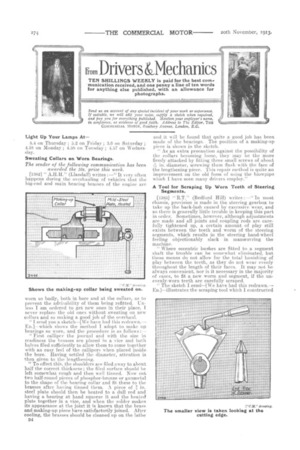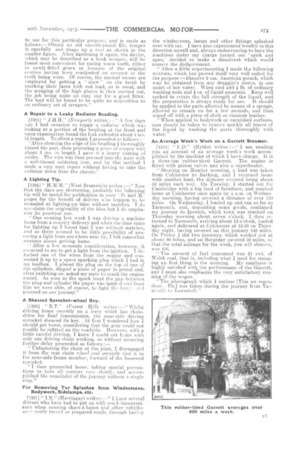Hom Drivers &Mechanics
Page 20

Page 21

If you've noticed an error in this article please click here to report it so we can fix it.
TEN SHILLINGS WEEKLY is paid for the best communication received, and one penny a line of ten words for anything else published, with an allowance for photographs.
Light Up Your Lamps At
5.4 on Thursday ; 5.2 on Friday ; 5M on Saturday ; 4.53 on Monday ; 4.58 on Tuesday ; 4.57 on Wednesday.
Sweating Collars on Worn Bearings.
The sender of the following communication has been. awarded the ws. prize this week.
[1:1821" A.H.H." (Llandaff) writes :—" It very often happens during the overhauling of vehicles that the big-end and main bearing brasses of the. engine are worn so badly, both in bore and at the collars, as to prevent the advisability of them being refitted. Unless I am ordered to get new ones in their place, T. never replace the old ones without sweating on new collars and so making a good job of the overhaul.
"I send you a sketch—{We have had this redrawn.— Mil—which shows the method I adopt to make up bearings so worn, and the procedure is as follows :—
" First calliper the journal and with the size in readiness the brasses are placed in a vice and both halves filed sufficiently to allow them to come together with an easy feel of the callipers when placed inside the bore. Having settled the diameter, attention is then given to the lengthening.
"To affect this, the, shoulders are filed away to about half the correct thickness; the filed surface should be left somewhat rough and then well tinned. Now cut two half-round pieces of phosphor-bronze or gunmetal to the shape of the bearing collar and fit these to the brasses after having tinned them. A piece of l in. steel plate should then be heated to a dull red and having a bearing at hand squeeze it and the heated plate together in a vice, and when the solder makes its appearance at the joint it is known that the brass and making-up piece have satisfactorily joined. After cooling, the brasses should be cleaned up on the lathe
D4 and it will be found that quite a good job has been made of the bearings.. The position of a making-up piece is shown in the sketch.
" As an extra precaution against the possibility of the collars becoming loose, they may be the more firmly attached by fitting. three small screws of about in. diameter, screwing them Hush with, the face of the lengthening piece. 'Phis repair method is quite an improvement on the old form of using the blowpipe which I have seen many drivers employ."
A Tool for Scraping Up Worn Teeth of Steering Segments.
f.13831 " RT." (Bedford Hill) writes :—" In most chassis, provision is made in the steering gearbox to take up the back-lash caused by excessive wear, and so there is generally little trouble in keeping this part in order. Sometimes, however, although adjustments are made and all joints and coupling rods are carefully tightened up, a certain amount of play still exists between the teeth and worm of the steering segments, which results in the steering hand-wheel feeling objectionably slack in manoeuvring the machine,
" Where eccentric bushes are fitted to a. segment shaft the trouble can be somewhat eliminated, but these means do not allow for the total banishing of play between the teeth, as they do not wear evenly throughout the length of their faces. It may not be always convenient, nor is it necessary in the majority of eases, to fit. a new worm and segment, if the unevenly-worn teeth are carefully scraped.
" The sketch I send—[We have had this redrawn.En.]—illustrates the scraping tool which I constructed to use for this particular purpose, and is made as follews :—Obtain an old smooth-round file, temper it carefully and shape up a tool as shown in the smaller figure. After hardening it. again, the device, which may be described as a hook scraper, will be Sound most convenient for easing worm teeth, either in newly-fitted gears or because of the original (:entres having been readjusted on account of the teeth being worn. Of course, the normal means are employed for getting a " show" on the teeth by marking their faces with red lead, as is usual, and the scraping of the high places is then carried out, the, job being quite an easy one for a. good. fitter. The tool will be found to be 'quite an acquisition to an ordinary set of scrapers."
A Repair to a Leaky Radiator Beading.
[1384] " J.H.H." (Newport) writes :—" A few days ago I had occasion to repair a radiator which was leaking at a portion of the beading at the front and upon examination found the leak extended about 4 ins. in length. To effect a repair I proceeded as follows :- "After cleaning the edge of the beading I thoroughly tinned the part, then procuring a piece of copper wire about 5 ins. in length I gave it a heavy coating of solder. The wire was then pressed into the joint with a. well-tinned soldering iron, and by this method I made a very neat repair without. having to take the radiator down from the chassis."
A Lighting Tip.
[1385] " H.M.M." (West Bromwich) writes :—" Now that the days are shortening, probably the following tip will be useful for publication in your 'P. and M.' pages for the benefit of drivers who happen to be stranded at lighting-up time without matches. I do not claim the originality of the idea but I do emphasize its practical use.
"One evening last week I was driving a machine home from a country delivery and when the time came for lighting up I found that I was without matches, and as there seemed to be little possibility of procuring a light from anywhere near by, I felt somewhat anxious about getting home. 'After a few moments consideration, however, it ()milled to me to get a light from the ignition. I detached one of the wires from the engine and connected it up to a spare sparking plug which I had in my toolbox. I placed the plug on the top of one of the cylinders, dipped a piece of paper in petrol and, after switching on, asked my mate to crank the engine round. As soon as the spark leapt the gap between the plug and cylinder the paper was ignited and from this we were able, of course, to light the lamp sed proceed on our journey."
A Sheared Sprocket-wheel Key.
0386] " B.T." (Forest Hill) writes Whilst
driving home recently on a lorry which has chaindrive for final transmission, the near-side driving sprocket sheared its key. At first I wondered how I should get home, considering that the gear could not readily be refitted on the roadside. However, with a little careful driving, I knew I could net home with only one driving chain working, so without incurring further delay proceeded as follows :—
" Unfastening the chain at the joint, I disengaged it from, the rear chain wheel and securely tied it to the near-side frame member, forward of the loosened sprocket.
"I then proceeded home, taking special precautions to turn all corners very slowly, and aceomplished the remainder of the journey without a single stop."
For Removing Tar Splashes front Windscreens, Bodywork, Sidelamps, etc.
[1387] " LB." (Harringay) writes :---" I know several drivers who have had to put up With much inconvenience when running chars-h-bancs and other vehicles over newly tarred or prepared roads, through having the windscreens, lamps and other fittings splashed over with tar. I have also experienced trouble in this direction myself and, always endeavouring to have the machines under my charge turned out 'spick and span,' decided to make a dissolvent which would remove the disfigurement. " After a little experimenting I made the following mixture, which has proved itself very well suited for the purpose :—Dissolve 2 ozs. American potash, which may be obtained from any druggist's stores, in one quart of hot water. When cool add * lb. of ordinary washing soda and oz. of liquid ammonia. Keep well corked to retain the full strength of the liquid, and the preparation is always ready for use. It should be applied to the parts affected by means of a sponge, allowed to remain on for a few seconds, and then wiped off with a piece of cloth or chamois leather. " When applied to bodywork or varnished surfaces, care should be taken to remove quickly all traces of the liquid by washing the parts thoroughly with water."
An Average Week's Work on a Garrett Steamer.
[1388] " F.D." (Hythe) writes:—'' I am sending you an account of an averageweek's work accomplished by the machine of which I have charge. It is a three-ton rubber-tired Garrett. The engineis fitted with piston valves and also a superheater.
"Starting on Monday morning, a load was taken from Colchester to Barking, and I returned home with another load, the distance covered being about 50 miles each way. On Tuesday, 1 started out for Cambridge with a big load of furniture, and reached home at Colchester once again by 4 a.m. on Wednesday morning, having covered a distance of over 100 miles. On Wednesday, I loaded up and ran as far as -Yarmouth, and, depositing some gocds, continued my journey to Ipswich, which town was reached on Thursday morning about seven o'clock. I then re'turned to Yarmouth, arriving about 12 o'clock, loaded again, and delivered at Colchester at 12.30 on Thursday night, having covered on this journey 140 miles. On Friday I did two journeys, which worked out at about 40 miles, and on Saturday covered 30 miles, so that the total mileage for the week, you will observe, wa-s 410.
" The amount of fuel consumed was 21 cwt. of Welsh coed, that is, including what I used for steaming up first thing in the morning. My employer is highly satisfied witll the performance of the Garrett, and I must also emphasize the very satisfactory running of the wasgen.
"The photograph which I enclose [This we reproduce.-En.] was taken during the journey from Yarmouth to Lowestoft,"






















